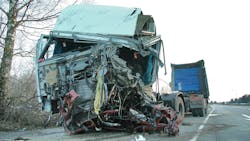Two things crossed my desk at roughly the same time, and together, they got me thinking about safety again.
The first was the release by the National Highway Traffic Safety Administration (NHTSA) containing estimates of traffic fatalities for the first nine months of 2021. The report projects that an estimated 31,720 people died in motor vehicle traffic crashes from January through September 2021. I know that there were fewer miles driven in 2020 compared to 2021, but the number of fatalities in 2021 is the highest number of fatalities during the first nine months of any year since 2006.
The other thing I saw was the U.S. Department of Transportation’s (USDOT) National Roadway Safety Strategy. In a letter at the beginning of the report, Transportation Secretary Pete Buttigieg said, “Almost 95% of our nation’s transportation deaths occur on America’s streets, roads, and highways, and they are on the rise.”
He went on to say that the status quo is unacceptable and that he believes these fatalities are preventable. I tend to agree with him. The report details what USDOT is calling the Safe System Approach, which focuses on safer people, safer roads, safer vehicles, safer speeds, and post-crash care.
There is not much an individual fleet can do about safer roads or post-crash care, but I think in the other areas we can make a difference. First, we can speak with manufacturers about offering more safety features on their vehicles, and we can then spec those safety features on the vehicles we order. Next, we can make sure our drivers are trained in the proper operation of those safety systems and that they understand that they are driver assistance systems that do not replace the need for the driver to operate the vehicle in a safe manner. Advanced driver assistance systems (ADAS) do not take the place of driving at the proper speed, keeping the proper distance between vehicles, etc.
When it comes to speed, fleets can set engine parameters for both speed at cruise and speed on the throttle and they can make sure that their dispatch and routing does not mean drivers have to exceed speed limits to make their delivery times.
Fleets need ongoing driver training on safe driving practices and policies that reinforce good driving. Some basic things like wearing seatbelts and only using hands-free mobile devices should not only be emphasized but also mandated.
While the NHTSA statistics are for all traffic fatalities and not just those involving trucks, we all should be concerned about them. We know that even in truck-involved accidents, it is usually not the truck driver’s fault that the accident occurred, but all too often trucking gets the blame. High jury verdicts in accidents involving trucks are a compelling reason to focus sharply on having trucks equipped with the latest safety technology and making sure drivers are trained to drive in a safe manner. But a better reason is that it is the right thing to do to make sure we get closer to zero highway fatalities.
Gino Fontana, CTP, is COO and EVP at Transervice Logistics Inc. Prior to this recent promotion, he was VP of operations at Berkeley Division and Puerto Rico. His operational expertise emphasizes cost savings, process efficiency and improvement, superior quality, and people management skills. He has more than 35 years of experience in the transportation and logistics industry with both operational and sales experience.
About the Author
Gino Fontana
Chief operating officer and executive vice president at Transervice Logistics Inc.
Gino Fontana, CTP, is COO and EVP at Transervice Logistics Inc. His operational expertise emphasizes cost savings, process efficiency and improvement, superior quality, and people management skills. He has more than 35 years of experience in the transportation and logistics industry with both operational and sales experience.
